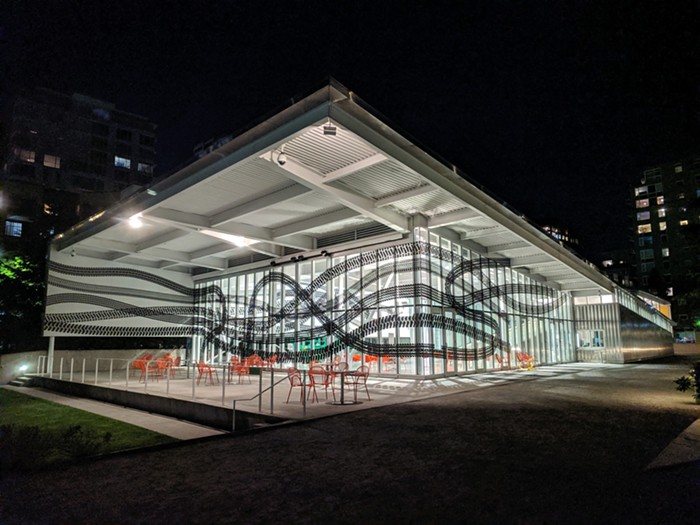
Make your way to Olympic Sculpture Park on a summer’s eve, like, say, tonight for the park’s annual outdoor edition of SAM Remix, and what draws your eye? With some of the most unobstructed waterfront views on Elliott Bay, there is a natural tendency to gaze out at cloudlines and mountaintop ridges that intermingle across Puget Sound. After last night’s closing of Summer at SAM with Black Belt Eagle Scout, there was even a spirited discussion in the men’s room about whether anyone had ever seen the fabled green flash of light at sunset. (Conclusion: Only on drugs.)
Brazilian artist Regina Silveira, whose temporary installation Octopus Wrap embraces the PACCAR Pavilion through March 2020, was drawn to more immediate surroundings. “The topography of this park is really special because it crosses many lines of traffic flow, from cars to trains,” she told The Stranger via telephone from her home in São Paulo. “I found it magical and was really impressed with the park’s strategy to take over the plot of land.”
That focus on Olympic Sculpture Park’s decidedly urban context inspired Octopus Wrap’s design: a series of black tire-track adhesives that crisscross the pavilion’s walls and ceiling, all emanating from tiny motorcycles. Wrapping the building in such a fashion—a longtime practice of Silveira’s—certainly makes the glass building stand out rather than blend into the landscape.
As a building at the park entrance, the pavilion’s glass enclosure has always served as a transition for me from the city to the natural world. I asked Silveira if traces of automotive street life detract from the respite from urban life that the park offers. “That’s pure fiction, there’s nothing about it that could disturb you,” she said. “Phantasmagorical graphic artwork doesn’t run this risk. Whoever wishes to enjoy nature can still do so by looking at the grass and the sea.” (Speaking of which, Silveira said a trip to the Seattle Aquarium inspired the tentacle-like name for the work, although she has riffed on the octopus name in previous iterations of her tire-track installations.)
Besides which, Silveira, who makes her home in São Paulo, a concrete jungle of 20 million people, scoffed at the notion that we need much of a refuge from the city. “You need to flee from the weight of urban life? Compared to São Paulo, Seattle is a paradise,” she laughed.
Silveira was particularly impressed that just a simple chain across the entrance (and some security guards) are enough to keep people out of the park at night, whereas in São Paulo the artwork would likely get tagged by the dark Brazilian street art style known as pichação. Silveira’s emphasis on vinyl adhesives that give the impression of black ink have made her “a type of sister” to the country’s fabled graffiti scene, she said, going back to her 1998 black animal footprint installation Tropel on the façade of the São Paulo Biennial.
Ultimately, the artist argued, it’s a sculpture park, not just a city park, and marquee works by Louise Bourgeois and Richard Serra also aim for what Silveira called “a voyage into interior thinking.”

One subset of park-goer who is not necessarily a fan? Brides-to-be. PACCAR Pavilion is a popular wedding venue and the installation is not sitting well with some. “I am devastated. I almost cried when I saw it. We are getting married in July and we picked the location in part because of the view. Tires tracks are not reflective of the space or the Northwest,” wrote one bride on a Reddit thread about the installation’s impact on wedding plans.
Having had the privilege of getting married at Olympic Sculpture Park last year and enjoying our wedding dinner under the multicolored hue of Spencer Finch’s The Western Mystery, I’ll reserve judgement. Silveira pulls no punches in her artist statement about the piece—the whole goal is not to be reflective of the space. "The overall intention is to superimpose a sort of fictional narrative over the narrative that belongs already to the building,” she said.
Nevertheless, I asked Silveira if she had any advice for the distraught brides. The artist was conciliatory—to a point. “I would encourage them to appreciate the beauty of the work when you are inside and how the light creates cool shadows on the ground,” she said. “A wedding dress could take on an unusual pattern with these marks.”
But, Silveira stressed, “art isn’t just about beautifying.”

















